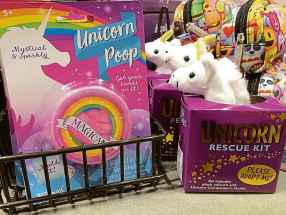Unicorn poop: One of the season’s trendiest kids toys
Read this article for free:
or
Already have an account? Log in here »
To continue reading, please subscribe:
Monthly Digital Subscription
$1 per week for 24 weeks*
- Enjoy unlimited reading on winnipegfreepress.com
- Read the E-Edition, our digital replica newspaper
- Access News Break, our award-winning app
- Play interactive puzzles
*Billed as $4 plus GST every four weeks. Offer only available to new and qualified returning subscribers. Cancel any time.
Read unlimited articles for free today:
or
Already have an account? Log in here »
Hey there, time traveller!
This article was published 10/12/2018 (2244 days ago), so information in it may no longer be current.
One of the hottest toys this holiday is a unicorn doll that poops slime.
The Poopsie Slime Surprise Unicorn does exactly as its name promises. Each kit comes with a sizable unicorn toy — one of the four character options, named Whoopsie Doodle, Oopsie Starlight, Rainbow Brightstar and Dazzle Darling — a plastic “glitter toilet” and all the supplies needed to make the poop-slime.
You then feed the unicorn some powder and liquid (using adorable spoons and cups, of course) and it then poops out a colourful fluid into its toilet. It’s pretty gross, but since it’s unicorn poop, that somehow makes it also fun.
Next, “unicorn magic” and “unicorn sparkle” are added, aka glitter, and the now-semi-solidified liquid has become a ball of iridescent slime to play with, or store in the keychain container provided.
This toy ticks all the 2018 trend boxes. Unicorns? Check. Slime? Check. Poop? Check. Collectable? Check. Amazing, Instagram-worthy packaging? Super check.
And its price tag is also that of trending toy: Poopsie Slime Surprise Unicorn costs a whopping $80, if you can find it at a retailer. If you’re looking at black-market Poopsie Unicorns, prices skyrocket beyond $100.
But, of course, Poopsie Slime Surprise Unicorn is just the most recent in a long line of strange toy crazes that have had kids — and consequently, parents — in a frenzy. Here are five of the biggest, and strangest, holiday toy trends of the past three decades.
Cabbage Patch Kids (1982)
Original price: US$25
Price in 2018 dollars: $65
In the 1980s, almost every child wanted to “adopt” a Cabbage Patch Kid. The cuddly baby dolls had a fabric body, a plastic head, hair made of yarn (unless they were bald) and sparkling little eyes. Part of the appeal was the fact the company, Coleco, claimed that each doll was unique in their look and dress, and also came with a birth certificate complete with first and middle names, making the adoption aspect feel all the more real.
Cabbage Patch Kids became a sensation, selling nearly three million units by the end of 1983. Parents flocked to department stores, sometimes camping out overnight just to get their hands on little Lora Julita or Jeremy Ike; they stormed aisles, got in fistfights and it is reported the frenzy surrounding Cabbage Patch Kids is one of the first instances of total consumer mayhem.
The Cabbage Patch shopping riots were so famous, in fact, that a limited HBO series inspired by them, called The Dolls, is now in the works. It is set to star and be executive produced by Laura Dern and Issa Rae.
Pogs (1994)
Original price: unavailable
Originally a game from the 1920s and ‘30s, Pogs were originally caps for milk bottles, and were brought back to life in the early 1990s by a teacher in Oahu, Hawaii.
The game involves two types of discs; the thinner, illustrated cardboard pieces (Pogs) and the heavier slammers. Each player chips in an equal number of Pogs into a stack, picture side down, and take turns hitting the pile with a slammer. All the Pogs that fall off and land face up are for that player to keep; whoever acquires the most Pogs by the time the stack is gone is the winner.

The game took off when the World POG Federation and the Canada Games Company reintroduced the discs under the POG brand name; kids traded and collected them, major companies used them as branding devices, sports teams and bands had their own custom series, and the popularity of Pogs went through the roof. During their brief time atop the trendiness ladder, from 1995 to 1997, Pogs earned an estimated US$140 million, according to Time.
Tamagotchi (1996)
Original price: US$17.99
Price in 2018 dollars: $28
One of the first forays into digital pet technology, Tamagotchi, which originated in Japan in 1996, was one of the top toys of the 1990s.The handheld virtual pets required almost constant attention; the feeding, the grooming, the playing and pooping, and if you turned a blind-eye for a too long, those little guys would die, or whatever the equivalent to death would be for a virtual pet, and the whole cycle would start again.
Tamagotchis bred a culture of obsession, to the point where many schools banned them because students were too focused on taking care of the egg-shaped toy during their lessons. Since they were released, about 70 million Tamagotchis have been sold worldwide.
Tickle Me Elmo (1996)
Original price: US$29
Price in 2018 dollars: $46.50
Who could forget the haunting chime of, “Uh-ha-ha-ha-hee-hee! That tickles!”
Turns out 1996 was a big year for toys, as pre-teens took care of their virtual pets, younger children were demanding Tickle Me Elmo, so much so the toy became almost impossible to obtain during the holiday season. Stores sold out in minutes, Elmo scalpers started upselling for literally thousands of dollars, and, as always, many desperate parents resorted to violence in order to have the giggling, vibrating — and let’s be honest, rather creepy — plush toy under their tree.
Furby (1998)
Original price: US$35
Price in 2018 dollars: $53.50
Perhaps the most terrifying toy trend of all is Furby. The part-owl-part-gremlin (and oft-parodied) electronic toy that blinks and talks and wiggles its creepy little ears was a massive hit the moment it became available in 1998.
The technology used inside Furby allowed the toy to repeat words it heard, essentially “learning” English from its surroundings. Furby also spoke a made-up language called Furbish, which is exactly as annoying as it sounds. Kids fell in love with the cute-ish appearance and Furby’s ability to converse, pushing the toy to sell 40 million units by 2005.
erin.lebar@freepress.mb.ca
Twitter: @NireRabel

Erin Lebar
Manager of audience engagement for news
Erin Lebar spends her time thinking of, and implementing, ways to improve the interaction and connection between the Free Press newsroom and its readership.
Our newsroom depends on a growing audience of readers to power our journalism. If you are not a paid reader, please consider becoming a subscriber.
Our newsroom depends on its audience of readers to power our journalism. Thank you for your support.






